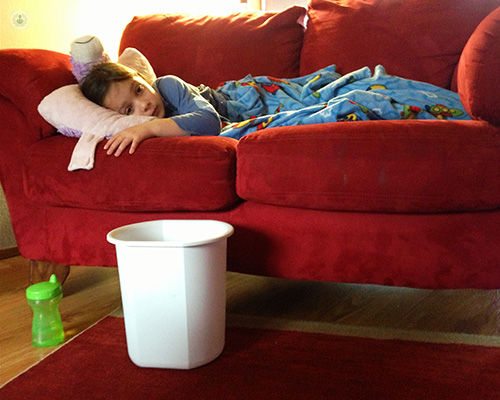Abdominal pain in children and infants
Written by:Tummy aches are fairly common in children and infants, but sometimes abdominal pain can be more serious and requires medical attention. Mr Stefano Giuliani, a leading paediatric surgeon, explains some common causes of abdominal pain in children and infants and how to recognise it.
What are some common causes of abdominal pain in children?
Abdominal pain in children is common and there are many causes of abdominal pain that are different based on the age of the child. We can, in general, divide abdominal pain into acute and chronic. Acute means that the onset of the pain is usually within the last six months; whereas chronic abdominal pain has to have lasted for at least six months and is often recurrent. It is important, especially in children, to understand if the cause of the abdominal pain is a medical problem or a surgical problem.

The most common cause of abdominal pain in children is gastroenteritis, which is an infection that can be viral or bacterial in origin. The most common surgical cause of abdominal pain in children is acute appendicitis. As mentioned before, there are many causes of abdominal pain and some causes are specific to certain ages. For example, an infant in the first year of life can have abdominal pain related to a blocked inguinal hernia, whereas older infants from six months to about two years often have abdominal pain caused by intussusception.
Intussusception in this age group is characterised by the fact that the intestine has folded into another piece of the intestine, causing a blockage. In older children, usually after the age of three years, the most common surgical cause of abdominal pain is acute appendicitis and this has characteristics that are similar to adults when the child is older than 6 or 7 years old.
How is abdominal pain diagnosed in children?
In children we diagnose abdominal pain based on an accurate history taking; including their age, associated symptoms of the abdominal pain and also details on the location of the pain in the abdomen. Following a history taking, it is very important to perform a very detailed physical examination. For this reason, it is important to be seen by an expert paediatric surgeon who has skills in performing a very accurate physical examination. In most cases we are able to make a diagnosis with just a medical history and a physical examination.
There are a few cases where we need to request some blood tests or some radiologic investigations, such as an ultrasound scan of the abdomen or a CT scan or an MRI of the abdomen. The interpretation of these will help us to define the cause of the pain.
How can you recognise abdominal pain in a baby?
Abdominal pain in babies can be very challenging to recognise and we often need to use associated symptoms to define the nature of the pain. In particular, if a baby has inconsolable crying, vomiting, diarrhoea with blood or abdominal distension (a bloated abdomen), these are signs that the baby is suffering or may be suffering from abdominal pain.
How can I tell if abdominal pain is appendicitis?
Appendicitis is the most common cause of surgical abdominal pain in children. In older children, usually after the age of six or seven, appendicitis presents in a similar way to adult acute appendicitis. To distinguish appendicitis from other types of abdominal pain, it is very important to note the onset of the pain in relation to other symptoms. This is because abdominal pain in the paraumbilical area is often the first symptom of acute appendicitis. Additionally, the pain usually migrates in 24 to 48 hours to the right-hand side of the abdomen. Within this timeframe, the child develops other symptoms such as a low-grade fever, nausea, or vomiting, and sometimes loose stools.
In younger children below the age of 6, the diagnosis of acute appendicitis is more challenging. This is caused by the fact that the time from the onset of the symptoms to having complicated appendicitis, or even peritonitis, can be really short. Therefore, if you have a child below the age of 6 with abdominal pain that is not moving a lot and has a fever, these are red flags to bring the child to see a doctor as soon as possible to make sure that the possible diagnosis of acute appendicitis can be made in a quick and timely fashion.
If you are concerned about your child’s health, and you would like to see a top paediatric surgeon, make an appointment now.


